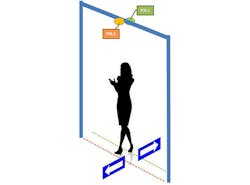Report: Advanced Occupancy Sensors Could Save Thousands in Energy Costs
An advanced building control currently in development could reduce the annual energy bill of a large office building by 18 percent with no loss of comfort, a report from the U.S. Department of Energy’s Pacific Northwest National Laboratory says.
The report, “Energy Savings for Occupancy-Based Control (OBC) of Variable-Air-Volume (VAV) Systems” (http://bit.ly/PNNL_OBC), is based on extensive simulations of an advanced building control capable of sensing the number of people in different zones of a building and adjusting fan speed and air movement accordingly.
“Technology available today doesn’t detect how many people are in a room, and so airflow is at maximum capacity nearly constantly,” engineer Guopeng Liu, the lead author of the report, said. “That creates a big demand to reheat the air before it enters the rooms.”
When used for both ventilation and lighting, occupancy sensors that count the number of people in rooms will save approximately 28 times more energy than existing sensors, the team estimates.
The new sensors likely will become available within the next few years.
“We undertook this study to try to determine if this is a technology worth pursuing vigorously,” team leader Michael Brambley said. “The answer clearly is yes.”
In conducting its study, the team focused on a prototypical commercial office building with a total footprint of approximately 500,000 sq ft. The simulation was programmed for heating to take place if temperatures dropped below 70°F and cooling to take place at temperatures of 75°F and above. The thresholds were adjusted by 10°F on evenings and weekends. Occupancy patterns were estimated based on past studies.
In 13 of the nation’s 15 climate regions, the advanced controls were estimated to save at least $40,000 annually. In two cities—Baltimore and Fairbanks, Alaska—the savings were more than $100,000 a year because of the greatly reduced need to heat air being pumped in from the cold outdoors. Even in the two cities where the impact of the controls was expected to be slightest—El Paso, Texas, and Miami—savings were $33,400 and $23,500, respectively.
“While buildings have gotten much more efficient in the last two decades, there are still huge gains to be had,” Brambley said. Brambley and Liu said existing buildings are a prime target for the advanced controls.
The team, which also included mechanical engineer Jian Zhang and engineer Robert Lutes, found that advanced controls for ventilation offer about eight times as much savings as advanced controls for lighting. When HVAC systems alone are considered, the advanced controls cut energy use by nearly 40 percent.
A stumbling block to the new technology is that certain advanced controls might require modification of building codes. For instance, current codes require some ventilation at all times, no matter how many people are present.
About the Author
Scott Arnold
Executive Editor
Described by a colleague as "a cyborg ... requir(ing) virtually no sleep, no time off, and bland nourishment that can be consumed while at his desk" who was sent "back from the future not to terminate anyone, but with the prime directive 'to edit dry technical copy' in order to save the world at a later date," Scott Arnold joined the editorial staff of HPAC Engineering in 1999. Prior to that, he worked as an editor for daily newspapers and a specialty-publications company. He has a bachelor's degree in journalism from Kent State University.

